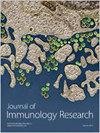中性粒细胞和中间单核细胞频率反映 ANCA 相关性血管炎的疾病活动性和复发倾向
IF 3.5
3区 医学
Q2 IMMUNOLOGY
引用次数: 0
摘要
抗中性粒细胞胞浆抗体(ANCA)相关性血管炎(AAV)是一组影响小血管的自身免疫性疾病,包括肉芽肿伴多血管炎(GPA)和显微镜下多血管炎(MPA)。在这项研究中,我们调查了一大批 AAV 患者的粒细胞和单核细胞亚群,重点是疾病活动性和复发倾向。研究对象包括 105 名 GPA 或 MPA 患者和 126 名健康对照者(HCs)。研究人员收集了所有患者的临床和实验室数据,包括疾病活动性、复发倾向和药物治疗。使用流式细胞术评估了循环中的嗜酸性粒细胞、嗜碱性粒细胞、中性粒细胞和单核细胞。单核细胞被细分为经典(CD14++CD16-)、中间(CD14++CD16+)和非经典(CD14-CD16+)单核细胞。对成熟(CD16high)或新释放(CD16dim)的中性粒细胞以及 CD177+ 中性粒细胞的频率进行了定义。与 HC 相比,AAV 患者的中间单核细胞、成熟和新释放的中性粒细胞频率增加,CD177+ 中性粒细胞群体扩大。MPA 患者与 GPA 患者的不同之处在于经典单核细胞的频率较低。在 ANCA 表型方面没有观察到细胞频率的差异。来自 23 名患者的配对数据显示,活动性疾病与成熟中性粒细胞的频率增加和单核细胞(尤其是中间单核细胞)的频率降低有关。此外,有复发倾向的 GPA 患者显示成熟中性粒细胞的频率增加,CD177+ 的表达增加。而复发的 MPA 患者则表现出中间单核细胞的减少。最后,利妥昔单抗治疗与经典单核细胞和中间单核细胞频率增加有关。总之,AAV 患者表现出不同中性粒细胞和单核细胞亚群的倾斜,这与疾病亚型、疾病活动性、利妥昔单抗治疗和复发倾向有关。这些变化可能有助于炎症过程,并有可能用作预测复发的生物标志物。本文章由计算机程序翻译,如有差异,请以英文原文为准。
Disease Activity and Tendency to Relapse in ANCA-Associated Vasculitis Are Reflected in Neutrophil and Intermediate Monocyte Frequencies
Antineutrophil cytoplasmic antibody (ANCA)-associated vasculitis (AAV) is a group of autoimmune diseases with inflammation affecting small blood vessels and includes granulomatosis with polyangiitis (GPA) and microscopic polyangiitis (MPA). In this study, we investigated granulocyte and monocyte subsets in a large cohort of AAV patients with emphasis on disease activity and tendency to relapse. A cohort of 105 patients with GPA or MPA and 126 healthy controls (HCs) were included. Clinical and laboratory data were collected for all patients, including disease activity, tendency to relapse, and pharmacological treatment. Using flow cytometry, circulating eosinophils, basophils, neutrophils, and monocytes were assessed. The monocytes were subdivided into classical (CD14++CD16−), intermediate (CD14++CD16+), and nonclassical (CD14−CD16+) monocytes. Mature (CD16high) or newly released (CD16dim) neutrophils were defined, as well as the frequency of CD177+ neutrophils. AAV patients displayed increased frequencies of intermediate monocytes, mature and newly released neutrophils, and an expanded population of CD177+ neutrophils compared to HC. MPA patients differed from GPA patients in terms of lower frequency of classical monocytes. No differences in cell frequencies regarding ANCA phenotype were observed. Paired data from 23 patients demonstrated that active disease was associated with an increased frequency of mature neutrophils and a decreased frequency of monocytes, in particular intermediate monocytes. Moreover, GPA patients with a tendency to relapse displayed an increased frequency of mature neutrophils with increased expression of CD177+. Relapsing MPA patients, on the other hand, showed decreased frequency of intermediate monocytes. Finally, rituximab treatment was associated with increased frequencies of classical and intermediate monocytes. In conclusion, AAV patients exhibit a skewing of different neutrophil and monocyte subpopulations that are associated with disease subtypes, disease activity, rituximab treatment, and propensity to relapse. These changes may contribute to the inflammatory process and could potentially be used as biomarkers for relapse prediction.
求助全文
通过发布文献求助,成功后即可免费获取论文全文。
去求助
来源期刊

Journal of Immunology Research
IMMUNOLOGY-
CiteScore
6.90
自引率
2.40%
发文量
423
审稿时长
15 weeks
期刊介绍:
Journal of Immunology Research is a peer-reviewed, Open Access journal that provides a platform for scientists and clinicians working in different areas of immunology and therapy. The journal publishes research articles, review articles, as well as clinical studies related to classical immunology, molecular immunology, clinical immunology, cancer immunology, transplantation immunology, immune pathology, immunodeficiency, autoimmune diseases, immune disorders, and immunotherapy.
 求助内容:
求助内容: 应助结果提醒方式:
应助结果提醒方式:


